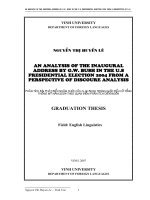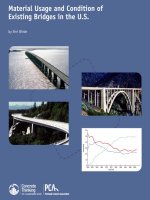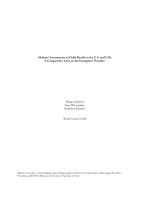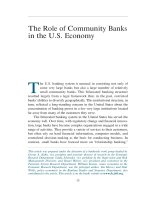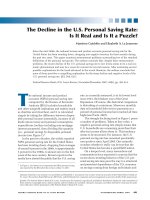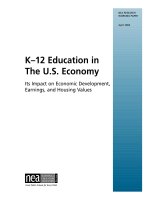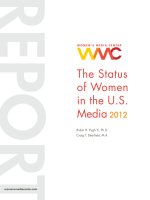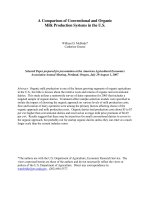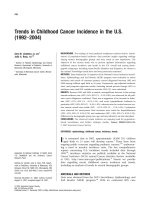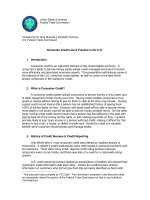Trends in Childhood Cancer Incidence in the U.S. (1992–2004) pdf
Bạn đang xem bản rút gọn của tài liệu. Xem và tải ngay bản đầy đủ của tài liệu tại đây (168.23 KB, 17 trang )
Trends in Childhood Cancer Incidence in the U.S.
(1992–2004)
Amy M. Linabery, MS, MPH
1
Julie A. Ross, PhD
1,2
1
Division of Pediatric Epidemiology and Clinical
Research, Department of Pediatrics, University of
Minnesota, Minneapolis, Minnesota.
2
University of Minnesota Cancer Center, Minnea-
polis, Minnesota.
BACKGROUND. The etiology of most pediatric neoplasms remains elusive. Exami-
nation of population-based incidence data provides insight regarding etiology
among various demographic groups and may result in new hypotheses. The
objective of the current study was to present updated information regarding
childhood cancer incidence and trends in the U.S. overall and among demo-
graphic subgroups, including Asian/Pacific Islanders and Hispanics, for whom to
the authors’ knowledge trends have not been previously examined.
METHODS. Data obtained by 13 registries of the National Cancer Institute’s Surveil-
lance, Epidemiology, and End Results (SEER) program were evaluated to assess
incidence and trends of common primary cancers diagnosed between 1992 and
2004 among children aged birth to 19 years. Frequencies, age-adjusted incidence
rates, and joinpoint regression results, including annual percent change (APC) in
incidence rates (and 95% confidence intervals [95% CI]), were calculated.
RESULTS. Between 1992 and 2004, a modest, nonsignificant increase in the average
annual incidence rate (APC, 0.4%; 95% CI, 20.1%–0.8%) was observed for all pedi-
atric cancer diagnoses combined. There was a suggestion of an increase in leuke-
mia (APC, 0.7%; 95% CI, 20.1%–1.5%), and acute lymphoblastic leukemia in
particular (APC, 0.8%; 95% CI, 20.4%–1.9%), whereas rates for central nervous sys-
tem tumors overall were stable (APC, 20.1%; 95% CI, 21.1%–1.0%); 2 joinpoints
were observed for astrocytoma. Rate increases were noted for hepatoblastoma
(APC, 4.3%; 95% CI, 0.2%–8.7%) and melanoma (APC, 2.8%; 95% CI, 0.5%–5.1%).
Differences by demographic group (sex, age, and race/ethnicity) are also described.
CONCLUSIONS. The observed trends reinforce an ongoing need for population-
based surveillance and further etiologic studies. Cancer 2008;112:416–32.
Ó 2007 American Cancer Society.
KEYWORDS: epidemiology, childhood cancer, incidence, trends.
I
t is estimated that in 2007, approximately 10,400 U.S. children
aged birth to 14 years will develop cancer.
1
There have been
ongoing public concerns regarding pediatric cancers,
2–6
underscor-
ing a need to monitor incidence rates. The last comprehensive
reports concerning U.S. incidence trends included data through
1995
7,8
; incidence statistics are publicly available in the National
Cancer Institute’s (NCI’s) annual Cancer Statistics Review (available
at URL: />9
Herein we provide
data regarding recent childhood cancer incidence and trends,
including an analysis of trends in several demographic groups.
MATERIALS AND METHODS
Data were obtained from the NCI’s Surveillance, Epidemiology, and
End Results (SEER) program.
10
With an estimated 98% case
Address for reprints: Julie A. Ross, PhD, Depart-
ment of Pediatrics, University of Minnesota, 420
Delaware Street SE, MMC 422, Minneapolis, MN
55455; Fax: (612) 626-4842; E-mail: rossx014@
umn.edu
Supported by National Institutes of Health Grant
T32 CA099936 and the Children’s Cancer
Research Fund.
Received December 27, 2006; revision received
August 14, 2007; accepted August 16, 2007.
ª 2007 American Cancer Society
DOI 10.1002/cncr.23169
Published online 11 December 2007 in Wiley InterScience (www.interscience.wiley.com).
416
ascertainment rate,
11
the SEER 13 registries capture
information regarding demographics, tumor site and
morphology, stage at diagnosis, treatment, and vital
status, representing approximately 14% of the U.S.
population.
10
Between 1992 and 2004, SEER actively
collected data on all cancer cases (excluding nonme-
lanoma skin cancers) in Connecticut, Hawaii, Iowa,
New Mexico, and Utah; in the metropolitan areas of
Atlanta, Detroit, Los Angeles, San Francisco-Oakland,
San Jose-Monterey, and Seattle-Puget Sound; and
from rural Georgia and the Alaskan Native Tumor
Registry. The use of the expanded SEER dataset from
1992 onward permitted the evaluation of the most
recent trends and facilitated the calculation of inci-
dence rates among Hispanics and Asian/Pacific
Islanders.
Histology and topography codes from the third
edition of the International Classification of Diseases
for Oncology (ICD-O-3)
12
were used in classifying
cases of 15 common cancers and 8 subtypes (Table
1). We included all first malignancies diagnosed dur-
ing the period 1992 through 2004 among those aged
19 years; 95% of diagnoses were confirmed by his-
tology. Annual population estimates used in the cal-
culation of incidence rates were obtained by the
SEER program from the U.S. Census Bureau. The
U.S. 2000 standard population (age <1 year, ages 1–
4 years, ages 5–9 years, ages 10–14 years, and ages
15–19 years) was used in direct age standardization.
Statistical Analysis
Frequencies and age-adjusted incidence rates were
calculated using SEER*STAT software,
13
in which
incidence rates are reported as the number of cases
per 1,000,000 person-years of follow-up. To examine
incidence trends the annual percent change (APC)
and 95% confidence intervals (95% CIs) were calcu-
lated using Joinpoint software
14
to perform weighted
least-squares regression, in which the independent
variable was calendar year and the dependent vari-
able was the natural logarithm of the age-adjusted
incidence rate.
9
Joinpoint models were employed to
determine when the trend changed in magnitude
and/or direction during the period 1992 through
2004, allowing a maximum of 3 joinpoints and a
minimum of 2 years between consecutive joinpoints
and between joinpoints and endpoints.
9,14,15
The
Joinpoint permutation test adjusts for multiple com-
parisons to ensure an overall type I error rate of 0.05
for a given trend.
14
Rates and trends within sex (male and female),
age group (age <1 year, ages 1–4 years, ages 5–9
years, ages 10–14 years, and ages 15–19 years), race
(white, black, and Asian/Pacific Islander) and ethni-
city (Spanish Hispanic-Latino and non-Spanish His-
panic-Latino) were evaluated. Trends involving 1
years with <10 cases, as denoted in Table 2, should
be interpreted with caution. Cases indicating Ameri-
can Indian/Alaskan Native and those with an
unknown/unspecified race were excluded from sub-
group analysis because there were too few cases to
allow for a trend analysis.
This study was approved by the University of
Minnesota Institutional Review Board.
RESULTS
Overall
Between 1992 and 2004, 22,694 incident malignant
neoplasms were reported among those patients aged
<20 years within the 13 SEER registries examined
(Table 2). The average annual age-adjusted incidence
rate was 158 per 1,000,000 person-years and there
was a suggestion of a positive trend (APC, 0.4%; 95%
CI, 20.1%–0.8%) (Table 2).
Frequencies, incidence rates, and results of the
best fit joinpoint regression models for each of the
cancer subtypes examined are provided in Table 2.
None of the rates changed in a strictly monotonic
fashion because each of the cancer diagnoses is rare
and subject to random fluctuation; trends are best
described by joinpoint results. Rates increased sub-
stantially over the time period for melanoma (APC,
2.8%; 95% CI, 0.5%–5.1%), hepatoblastoma (APC,
4.3%; 95% CI, 0.2%–8.7%), and other/unspecified
central nervous system (CNS) tumors (APC, 5.4%;
95% CI, 0.8%–10.3%). Two joinpoints were found for
astrocytoma; the rate decreased initially (1992–1999:
APC, 22.9%; 95% CI, 25.2%–20.5%) followed by a
rapid increase (1999–2002: APC, 7.8%; 95% CI,
29.1%–27.9%) and a subsequent decline (2002–2004:
APC, 28.3%; 95% CI, 223.1%–9.4%). A change in the
magnitude and direction of the trend was observed
for other/unspecified leukemias; a significant
decrease was observed between 1992 and 1996 (APC,
218.6%; 95% CI, 231.6%–23.2%) and a significant
increase was detected thereafter (APC, 7.0%; 95% CI,
0.1%–14.3%). The trends for other cancer subgroups
were indistinguishable from a slope of 0, although
the data indicate a possible increase for leukemia
overall (acute lymphoblastic leukemia [ALL] and
acute myeloid leukemia [AML]) and non-Hodgkin
lymphoma (NHL), and suggest a decrease for Wilms
tumor and Ewing sarcoma. Notably, the rate of CNS
tumors overall remained steady over the time period
examined (APC, 20.1%; 95% CI, 21.1%–1.0%). The
observed and expected rates, as determined by join-
Childhood Cancer Incidence Trends/Linabery et al. 417
TABLE 1
International Classification of Diseases for Oncology, Third Edition Histology and Topography Codes
Disease Code
Any leukemia 9800–9801, 9805, 9820, 9823, 9826–9827, 9831–9837, 9840, 9860–9861, 9863, 9866–9867, 9870–9876, 9891, 9895–9897, 9910,
9920, 9930–9931, 9940, 9945–9946, 9948
Acute lymphocytic leukemia 9826, 9835–9837
Acute myeloid leukemia 9840, 9861, 9866–9867, 9870–9874, 9891, 9895–9897, 9910, 9920, 9931
Other leukemias (lymphoid leukemias other than ALL/other specified and unspecified leukemias) 9800–9801, 9805, 9820, 9823, 9827, 9831–9834, 9860, 9863, 9875–9876, 9930, 9940, 9945–9946, 9948
Hodgkin disease 9650–9655, 9659, 9661–9665, 9667
Non-Hodgkin lymphoma 9590–9591, 9596, 9670–9671, 9673, 9675, 9678–9680, 9684, 9687, 9689–9691, 9695, 9698–9702, 9705, 9708–9709, 9714, 9716–
9719, 9727–9729, 9731–9734, 9760–9762, 9764–9769, 9970
Any CNS tumor 8000–8005(C70.0–C72.9, C75.1–C75.3), 8270–8281, 8300, 9350–9352, 9360–9362, 9380(C70.0–C72.9, C75.1, C75.3), 9381–9384,
9390–9394, 9400–9413, 9420–9424, 9430, 9440–9442, 9444, 9450–9451, 9460, 9470–9474, 9480, 9492–9493, 9500(C71.0–
C71.9), 9501–9504(C70.0–C72.9), 9505–9508, 9530–9539, 9582
Ependymoma 9383, 9391–9394
Astrocytoma 9380(C72.3), 9384, 9400–9411, 9420–9424, 9440–9442
PNETs (PNET; medulloblastoma/PNET/pineoblastoma/intracranial neuroblastoma) 9362, 9470–9474, 9480, 9500(C71.0–C71.9)
Other gliomas 9380(C70.0–C72.2, C72.4–C72.9, C75.1, C75.3), 9381–9382, 9430, 9444, 9450–9451, 9460
Other CNS tumors (choriod plexus tumors/medullopithelioma/atypical teratoid/rhabdoid tumors/
other specified and unspecified CNS tumors)
8000–8005(C70.0–C72.9, C75.1–C75.3), 8270–8281, 8300, 9350–9352, 9360–9361, 9390, 9412–9413, 9492–9493, 9501–
9504(C70.0–C72.9), 9505–9508, 9530–9539, 9582
Extracranial neuroblastoma 9490, 9500(C00.0–C70.9, C72.0–C80.9)
Retinoblastoma 9510–9514
Wilms tumor 8959–8960
Hepatoblastoma 8970
Osteosarcoma [9180–9187, 9191–9195, 9200](C40.0–C41.9, C76.0–C76.8, C80.9)
Ewing sarcoma 9260(C40.0–C41.9, C76.0–C76.8, C80.9)
Rhabdomyosarcoma 8900–8905, 8910, 8912, 8920, 8991
Nonrhabdomyosarcoma soft tissue sarcoma 8587, 8710–8713, [8800–8805, 8810–8811, 8813–8815, 8821, 8823, 8830, 8834–8835](C00.0–C39.9, C44.0–C76.8, C80.9), 8806,
8820, 8822, 8824–8827, 8831–8833, 8836, 8840–8842, 8850–8858, 8860–8862, 8870, 8880–8881, 8890–8898, 8921, 8963(C00.0–
C63.9, C65.9–C69.9, C73.9–C76.8, C80.9), 8982, 8990, 9040–9044, 9120–9125, 9130–9133, 9135–9136, 9140–9142, 9150, 9160–
9161, 9170–9175, [9180, 9210, 9220, 9240](C49.0–C49.9), 9231, 9251–9252, 9260(C00.0–C39.9, C47.0–C75.9), 9364(C00.0–
C39.9, C47.0–C63.9, C65.9–C69.9, C73.9–C76.8, C80.9), 9365(C00.0–C39.9, C47.0–C63.9, C65.9–C76.8, C80.9), 9373, 9491,
9540–9571, 9580–9581
Germ cell tumors [8000–8005, 8010–8041, 8050–8075, 8082, 8120–8122, 8130–8141, 8143, 8190–8201, 8210–8211, 8221–8241, 8244–8246, 8260–
8263, 8290, 8310, 8313, 8320, 8323, 8380–8384, 8430, 8440, 8480–8490, 8504, 8510, 8550, 8560–8573, 9000, 9014–9015, 9073,
9090–9091](C56.9, C62.0–C62.9), 8441–8444, 8450–8451, 8460–8473, 8590–8671, [9060–9065, 9070–9072, 9080–9085, 9100–
9101](C00.0–C55.9, C56.9–C72.9, C73.9–C76.8, C80.9), [9102–9105](C00.0–C55.9, C57.0–C61.9, C63.0–C69.9, C73.9–C75.0,
C75.4–C76.8, C80.9)
Thyroid carcinoma [8010–8041, 8050–8075, 8082, 8120–8122, 8130–8141, 8190, 8200–8201, 8211, 8230–8231, 8244–8246, 8260–8263, 8290, 8310,
8320, 8323, 8430, 8440, 8480–8481, 8510, 8560–8573](C73.9), 8330–8337, 8340–8347, 8350
Malignant melanoma 8720–8780, 8790
ALL indicates acute lymphocytic leukemia; CNS, central nervous system; PNET, primitive neuroectodermal tumor.
418 CANCER January 15, 2008 / Volume 112 / Number 2
TABLE 2
Frequencies, Incidence Rates, and Annual Percent Change in 13 SEER Registries From 1992–2004
Total Cases
1992–2004
Cancer No. (%)
Incidence
rate* Years APC
1
y
(95% CI) Years APC
2
y
(95% CI) Years APC
3
y
(95% CI) Years APC
4
y
(95% CI)
Total
{
22,694 (100%) 157.9 1992–2004 0.4 (20.1–0.8)
Leukemias 6129 (27%) 41.9 1992–2004 0.7 (20.1–1.5)
ALL 4697 (21%) 31.9 1992–2004 0.8 (20.4–1.9)
AML 1085 (5%) 7.5 1992–2004 1.0 (20.4–2.4)
Other/unspecified leukemias 347 (2%) 2.4 1992–1996 218.6 (231.6–23.2) 1996–2004 7.0 (0.1–14.3)
Hodgkin disease 1611 (7%) 11.7 1992–2004 20.8 (22.4–0.7)
Non-Hodgkin lymphoma 1472 (6%) 10.4 1992–2004 1.4 (20.1–3.0)
CNS tumors 4004 (18%) 27.6 1992–2004 20.1 (21.1–1.0)
Ependymoma 308 (1%) 2.1 1992–2004 20.5 (24.1–3.3)
Astrocytoma 1920 (8%) 13.3 1992–1999 22.9 ( 25.2–20.05) 1999–2002 7.8 (29.1–27.9) 2002–2004 28.3 (223.1–9.4)
PNET 971 (4%) 6.6 1992–2004 21.2 (23.1–0.7)
Other gliomas 664 (3%) 4.6 1992–2004 1.5 (20.9–4.0)
Other/unspecified CNS tumors 141 (0.6%) 0.9 1992–2004 5.4 (0.8–10.3)
k
Neuroblastoma (extracranial) 1107 (5%) 7.3 1992–2004 20.6 (22.9–1.7)
Retinoblastoma 514 (2%) 3.4 1992–2004 0.3 (21.5–2.1)
Wilms tumor 804 (4%) 5.3 1992–2004 22.1 (24.6–0.4)
Hepatoblastoma 216 (1%) 1.4 1992–2004 4.3 (0.2–8.7)
Osteosarcoma 660 (3%) 4.7 1992–2004 0.2 (21.4–1.8)
Ewing sarcoma 327 (1%) 2.3 1992–2004 23.4 (27.0–0.3)
Rhabdomyosarcoma 643 (3%) 4.4 1992–2004 0.8 (21.8–3.4)
Nonrhabdomyosarcoma soft tissue sarcoma 925 (4%) 6.6 1992–2004 0.8 (21.3–2.9)
Germ cell tumors 1607 (7%) 11.5 1992–2004 0.8 (20.7–2.4)
Thyroid carcinoma 764 (3%) 5.6 1992–2004 1.5 (20.7–3.6)
Malignant melanoma 672 (3%) 4.9 1992–2004 2.8 (0.5–5.1)
Sex Male
1992–2004
Cancer No. (%)
Incidence
rate* Years APC
1
y
(95% CI) Years APC
2
y
(95% CI) Years APC
3
y
(95% CI) Years APC
4
y
(95% CI)
Total
{
12,316 (100%) 167.0 1992–2004 0.4 (20.1–1.0)
Leukemias 3456 (28%) 46.1 1992–2004 0.7 (20.4–1.9)
ALL 2678 (22%) 35.6 1992–2004 0.6 (20.9–2.0)
AML 579 (5%) 7.8 1992–2004 1.9 (0.2–3.7)
Other/unspecified leukemias 199 (2%) 2.7 1992–1997 218.4 (230.5–24.1)
k
1997–2004 14.0 (2.4–26.9)
(continued )
Childhood Cancer Incidence Trends/Linabery et al. 419
TABLE 2
(continued )
Sex Male
1992–2004
Cancer No. (%)
Incidence
rate* Years APC
1
y
(95% CI) Years APC
2
y
(95% CI) Years APC
3
y
(95% CI) Years APC
4
y
(95% CI)
Hodgkin disease 818 (7%) 11.5 1992–2004 1.0 (21.4–3.5)
Non-Hodgkin lymphoma 997 (8%) 13.8 1992–2004 0.8 (21.3–3.0)
CNS tumors 2224 (18%) 29.9 1992–2004 20.4 (22.1–1.2)
Ependymoma 177 (1%) 2.4 1992–2004 23.8 (27.6–0.2)
k
Astrocytoma 1023 (8%) 13.9 1992–2004 20.6 (22.5–1.4)
PNET 584 (5%) 7.8 1992–2004 21.3 (24.5–2.0)
Other gliomas 356 (3%) 4.8 1992–2004 1.7 (21.2–4.6)
Other/unspecified CNS tumors 84 (0.7%) 1.1 1992–2004 5.3 (21.2–12.2)
k
Neuroblastoma 598 (5%) 7.7 1992–2004 21.6 (24.9–1.9)
Retinoblastoma 270 (2%) 3.4 1992–1994 14.3 (241.6–123.6) 1994–1997 223.0 (266.2–75.3) 1997–2000 36.3 (233.3–178.3) 2000–2004 25.7 (222.2–14.2)
Wilms tumor 367 (3%) 4.7 1992–2004 22.3 (24.0–20.05)
Hepatoblastoma 122 (1%) 1.6 1992–2004 5.5 (1.1–10.0)
k
Osteosarcoma 385 (3%) 5.4 1992–2004 20.4 (23.5–2.8)
Ewing sarcoma 202 (2%) 2.8 1992–2004 24.7 (29.9–0.8)
k
Rhabdomyosarcoma 372 (3%) 5.0 1992–2004 0.2 (23.1–3.5)
Nonrhabdomyosarcoma soft tissue sarcoma 502 (4%) 6.9 1992–2004 2.0 (20.6–4.7)
Germ cell tumors 984 (8%) 13.8 1992–2004 1.6 (20.3–3.6)
Thyroid carcinoma 130 (1%) 1.8 1992–2004 0.4 (26.6–8.0)
k
Melanoma 282 (2%) 4.0 1992–2004 3.8 (0.2–7.6)
Sex Female
1992–2004
Cancer No. (%)
Incidence
rate* Years APC
1
y
(95% CI) Years APC
2
y
(95% CI) Years APC
3
y
(95% CI) Years APC
4
y
(95% CI)
Total
{
10,378 (100%) 148.2 1992–2004 0.3 (20.3–0.9)
Leukemias 2673 (26%) 37.4 1992–2004 0.6 (20.8–2.0)
ALL 2019 (19%) 28.0 1992–2004 1.1 (20.6–2.8)
AML 506 (5%) 7.2 1992–2004 20.1 (21.9–1.8)
Other/unspecified leukemias 148 (1%) 2.1 1992–2004 23.3 (27.7–1.4)
k
Hodgkin disease 793 (8%) 11.9 1992–2004 22.4 (24.5–20.3)
Non-Hodgkin lymphoma 475 (5%) 6.9 1992–2004 2.8 (20.3–6.0)
CNS tumors 1780 (17%) 25.1 1992–2004 0.4 (20.8–1.6)
Ependymoma 131 (1%) 1.8 1992–1995 45.8 (9.3–94.5)
k
1995–1998 227.3 (255.4–18.4) 1998–2001 35.9 (216.4–121.0) 2001–2004 27.0 (224.6–14.7)
Astrocytoma 897 (9%) 12.7 1992–2004 20.2 (22.0–1.7)
PNET 387 (4%) 5.4 1992–2004 21.3 (24.4–1.9)
(continued )
420 CANCER January 15, 2008 / Volume 112 / Number 2
TABLE 2
(continued )
Sex Female
1992–2004
Cancer No. (%)
Incidence
rate* Years APC
1
y
(95% CI) Years APC
2
y
(95% CI) Years APC
3
y
(95% CI) Years APC
4
y
(95% CI)
Other gliomas 308 (3%) 4.4 1992–2004 1.4 (21.9–4.9)
Other/unspecified CNS tumors 57 (0.5%) 0.8 1992–2004 3.9 (25.0–13.8)
k
Neuroblastoma 509 (5%) 6.9 1992–2004 0.6 (22.2–3.5)
Retinoblastoma 244 (2%) 3.3 1992–2004 21.9 (24.9–1.3)
Wilms tumor 437 (4%) 5.9 1992–2004 22.1 (25.9–1.8)
Hepatoblastoma 94 (0.9%) 1.3 1992–2004 2.9 (23.7–10.0)
k
Osteosarcoma 275 (3%) 4.0 1992–1996 211.7 (224.4–3.0) 1996–2004 6.3 (1.1–11.8)
Ewing sarcoma 125 (1%) 1.8 1992–2004 21.2 (26.2–4.1)
k
Rhabdomyosarcoma 271 (3%) 3.8 1992–2004 1.7 (21.5–5.0)
Nonrhabdomyosarcoma soft tissue sarcoma 423 (4%) 6.2 1992–1999 5.1 (0.1–10.5) 1999–2002 216.9 (243.4–21.9) 2002–2004 19.0 (218.8–74.4)
Germ cell tumors 623 (6%) 9.1 1992–2004 20.3 (22.6–2.2)
Thyroid carcinoma 634 (6%) 9.5 1992–2004 1.6 (20.2–3.5)
Melanoma 390 (4%) 5.9 1992–2004 2.2 (20.9–5.5)
Age Group <1 Year
1992–2004
Cancer No. (%)
Incidence
rate* Years APC
1
y
(95% CI) Years APC
2
y
(95% CI) Years APC
3
y
(95% CI) Years APC
4
y
(95% CI)
Total
{
1677 (100%) 225.9 1992–2004 0.1 (21.3–1.4)
Leukemias 296 (18%) 39.9 1992–2004 0.8 (22.5–4.2)
ALL 139 (8%) 18.7 1992–2004 20.4 (25.3–4.7)
k
AML 109 (6%) 14.7 1992–2004 3.2 (21.8–8.3)
k
Other/unspecified leukemias 48 (3%) 6.5 1992–2004 22.5 (29.1–4.6)
k
Hodgkin disease 1 (0.06%) 0.1 —
Non-Hodgkin lymphoma 12 (0.7%) 1.6 —
CNS tumors 225 (13%) 30.3 1992–2004 0.3 (22.9–3.5)
Ependymoma 23 (1%) 3.1 —
Astrocytoma 79 (5%) 10.6 1992–2004 2.1 (22.6–7.1)
k
PNET 76 (5%) 10.2 1992–2004 24.5 (210.6–2.1)
k
Other gliomas 16 (1%) 2.2 —
Other/unspecified CNS tumors 31 (2%) 4.2 1992–2004 5.2 (22.7–13.7)
k
Neuroblastoma 402 (24%) 54.1 1992–2004 21.9 (25.5–1.9)
Retinoblastoma 196 (12%) 26.4 1992–2004 21.1 (23.1–0.8)
Wilms tumor 107 (6%) 14.4 1992–2004 24.0 (210.2–2.5)
k
(continued )
Childhood Cancer Incidence Trends/Linabery et al. 421
TABLE 2
(continued )
Age Group <1 Year
1992–2004
Cancer No. (%)
Incidence
rate* Years APC
1
y
(95% CI) Years APC
2
y
(95% CI) Years APC
3
y
(95% CI) Years APC
4
y
(95% CI)
Hepatoblastoma 78 (5%) 10.5 1992–2004 4.2 (21.9–10.7)
k
Osteosarcoma 1 (0.06%) 0.1 —
Ewing sarcoma 1 (0.06%) 0.1 —
Rhabdomyosarcoma 39 (2%) 5.3 —
Nonrhabdomyosarcoma soft tissue sarcoma 76 (5%) 10.2 1992–2004 10.4 (4.9–16.3)
k
Germ cell tumors 156 (9%) 21.0 1992–2004 0.3 (25.0–5.9)
k
Thyroid carcinoma 0 (0%) 0.0 —
Melanoma 5 (0.3%) 0.7 —
Age Group 1–4 Years
1992–2004
Cancer No. (%)
Incidence
rate* Years APC
1
y
(95% CI) Years APC
2
y
(95% CI) Years APC
3
y
(95% CI) Years APC
4
y
(95% CI)
Total
{
5913 (100%) 199.6 1992–2004 0.3 (20.5–1.1)
Leukemias 2526 (43%) 85.3 1992–2004 0.6 (20.9–2.0)
ALL 2169 (37%) 73.2 1992–2004 0.4 (21.4–2.3)
AML 279 (5%) 9.4 1992–2004 1.5 (22.9–6.2)
Other/unspecified leukemias 78 (1%) 2.6 1992–2004 2.7 (25.6–11.8)
k
Hodgkin disease 25 (0.4%) 0.8 —
Non-Hodgkin lymphoma 181 (3%) 6.1 1992–2004 22.2 (25.4–1.1)
k
CNS tumors 1,140 (19%) 38.5 1992–1996 24.8 (210.6–1.3) 1996–2001 5.7 (20.7–12.6) 2001–2004 25.1 (213.9–4.5)
Ependymoma 130 (2%) 4.4 1992–2004 21.2 (25.3–3.2)
k
Astrocytoma 493 (8%) 16.6 1992–2004 1.9 (20.3–4.2)
PNET 326 (6%) 11.0 1992–2004 22.2 (25.8–1.5)
Other gliomas 136 (2%) 4.6 1992–2004 0.1 (26.0–6.5)
k
Other/unspecified CNS tumors 55 (0.9%) 1.9 —
Neuroblastoma 557 (9%) 18.8 1992–2004 20.7 (23.0–1.7)
Retinoblastoma 296 (5%) 10.0 1992–2004 1.6 (21.6–4.8)
Wilms tumor 510 (9%) 17.2 1992–2004 21.5 (24.0–1.1)
Hepatoblastoma 120 (2%) 4.1 1992–2004 4.8 (0.9–8.8)
k
Osteosarcoma 9 (0.2%) 0.3 —
Ewing sarcoma 17 (0.3%) 0.6 —
Rhabdomyosarcoma 200 (3%) 6.8 1992–2004 21.7 (25.6–2.5)
k
Nonrhabdomyosarcoma soft tissue sarcoma 70 (1%) 2.4 1992–2004 1.0 (27.0–9.7)
k
Germ cell tumors 117 (2%) 3.9 1992–2004 0.7 (25.1–6.7)
k
(continued )
422 CANCER January 15, 2008 / Volume 112 / Number 2
TABLE 2
(continued )
Age Group 1–4 Years
1992–2004
Cancer No. (%)
Incidence
rate* Years APC
1
y
(95% CI) Years APC
2
y
(95% CI) Years APC
3
y
(95% CI) Years APC
4
y
(95% CI)
Thyroid carcinoma 1 (0.02%) 0.0 —
Melanoma 20 (0.3%) 0.7 —
Age Group 5–9 Years
1992–2004
Cancer No. (%)
Incidence
rate* Years APC
1
y
(95% CI) Years APC
2
y
(95% CI) Years APC
3
y
(95% CI) Years APC
4
y
(95% CI)
Total
{
3926 (100%) 107.4 1992–2004 0.3 (20.7–1.4)
Leukemias 1395 (36%) 38.2 1992–1999 2.8 (20.2–5.8) 1999–2004 23.9 (28.5–0.9)
ALL 1176 (30%) 32.2 1992–1999 3.6 (0.5–6.8) 1999–2004 24.0 (28.6–0.9)
AML 169 (4%) 4.6 1992–2004 20.9 (25.3–3.7)
k
Other/unspecified leukemias 50 (1%) 1.4 1992–2004 26.9 (215.2–2.3)
k
Hodgkin disease 141 (4%) 3.9 1992–2004 0.9 (22.2–4.0)
k
Non-Hodgkin lymphoma 302 (8%) 8.3 1992–2004 2.0 (20.7–4.8)
CNS tumors 1087 (28%) 29.7 1992–2004 0.6 (21.2–2.4)
Ependymoma 63 (2%) 1.7 1992–2004 4.9 (23.8–14.4)
k
Astrocytoma 515 (13%) 14.1 1992–2004 20.9 (23.8–2.1)
PNET 271 (7%) 7.4 1992–2004 1.3 (23.2–6.0)
Other gliomas 219 (6%) 6.0 1992–2004 3.1 (23.0–9.7)
k
Other/unspecified CNS tumors 19 (0.5%) 0.5 —
Neuroblastoma 108 (3%) 3.0 1992–2004 1.6 (23.5–7.0)
k
Retinoblastoma 19 (0.5%) 0.5 —
Wilms tumor 164 (4%) 4.5 1992–2004 23.5 (28.4–1.6)
k
Hepatoblastoma 15 (0.4%) 0.4 —
Osteosarcoma 90 (2%) 2.5 1992–2004 20.6 (25.5–4.5)
k
Ewing sarcoma 58 (1%) 1.6 1992–2004 21.6 (28.8–6.1)
k
Rhabdomyosarcoma 161 (4%) 4.4 1992–2002 3.5 (0.3–6.9)
k
2002–2004 226.7 (255.1–19.5)
Nonrhabdomyosarcoma soft tissue sarcoma 118 (3%) 3.2 1992–2004 21.1 (27.3–5.5)
k
Germ cell tumors 80 (2%) 2.2 1992–2004 1.7 (24.2–7.9)
k
Thyroid carcinoma 41 (1%) 1.1 —
Melanoma 38 (1%) 1.0 —
(continued )
Childhood Cancer Incidence Trends/Linabery et al. 423
TABLE 2
(continued )
Age Group 10–14 Years
1992–2004
Cancer No. (%)
Incidence
rate* Years APC
1
y
(95% CI) Years APC
2
y
(95% CI) Years APC
3
y
(95% CI) Years APC
4
y
(95% CI)
Total
{
4346 (100%) 121.1 1992–2004 0.4 (20.6–1.5)
Leukemias 990 (23%) 27.6 1992–2004 0.5 (20.7–1.9)
ALL 695 (16%) 19.4 1992–2004 0.7 (21.0–2.6)
AML 231 (5%) 6.4 1992–2004 1.2 (21.9–4.4)
Other/unspecified leukemias 64 (1%) 1.8 1992–2004 23.7 (28.6–1.5)
k
Hodgkin disease 409 (9%) 11.4 1992–2004 20.4 (23.2–2.4)
Non-Hodgkin lymphoma 404 (9%) 11.3 1992–2004 1.7 (21.1–4.6)
CNS tumors 906 (21%) 25.2 1992–2004 21.1 (23.0–1.0)
Ependymoma 52 (1%) 1.4 1992–2002 22.5 (26.9–2.1)
k
2002–2004 252.2 (284.3–45.1)
Astrocytoma 483 (11%) 13.5 1992–2004 21.9 (24.4–0.8)
PNET 190 (4%) 5.3 1992–2004 22.0 (25.4–1.6)
Other gliomas 159 (4%) 4.4 1992–2004 4.3 (22.4–11.5)
k
Other/unspecified CNS tumors 22 (0.5%) 0.6 —
Neuroblastoma 29 (0.7%) 0.8 —
Retinoblastoma 1 (0.02%) 0.0 —
Wilms tumor 19 (0.4%) 0.5 —
Hepatoblastoma 3 (0.07%) 0.1 —
Osteosarcoma 267 (6%) 7.4 1992–2004 0.2 (22.5–3.0)
Ewing sarcoma 109 (3%) 3.0 1992–2004 24.3 (27.7–20.7)
k
Rhabdomyosarcoma 117 (3%) 3.3 1992–2004 1.5 (24.8–8.3)
k
Nonrhabdomyosarcoma soft tissue sarcoma 276 (6%) 7.7 1992–2004 0.0 (23.3–3.4)
Germ cell tumors 266 (6%) 7.4 1992–2004 2.1 (21.3–5.5)
Thyroid carcinoma 160 (4%) 4.5 1992–2004 20.6 (25.3–4.3)
k
Melanoma 108 (2%) 3.0 1992–2004 6.7 (1.8–11.9)
k
Age Group 15–19 Years
1992–2004
Cancer No. (%)
Incidence
rate* Years APC
1
y
(95% CI) Years APC
2
y
(95% CI) Years APC
3
y
(95% CI) Years APC
4
y
(95% CI)
Total
{
6832 (100%) 200.8 1992–2004 0.4 (20.4–1.3)
Leukemias 922 (13%) 27.1 1992–2004 2.0 (20.3–4.5)
ALL 518 (8%) 15.2 1992–2004 3.3 (0.4–6.4)
AML 297 (4%) 8.7 1992–2004 0.9 (23.1–5.1)
Other/unspecified leukemias 107 (2%) 3.1 1992–2004 0.1 (27.0–7.8)
k
Hodgkin disease 1035 (15%) 30.4 1992–2004 21.3 (22.7–0.2)
Non-Hodgkin lymphoma 573 (8%) 16.8 1992–2004 2.3 (20.8–5.4)
(continued )
424 CANCER January 15, 2008 / Volume 112 / Number 2
TABLE 2
(continued )
Age Group 15–19 Years
1992–2004
Cancer No. (%)
Incidence
rate* Years APC
1
y
(95% CI) Years APC
2
y
(95% CI) Years APC
3
y
(95% CI) Years APC
4
y
(95% CI)
CNS tumors 646 (9%) 19.0 1992–2004 21.3 (24.1–1.5)
Ependymoma 40 (0.6%) 1.2 1992–2004 2.0 (29.0–14.4)
k
Astrocytoma 350 (5%) 10.3 1992–2004 21.2 (25.0–2.7)
PNET 108 (2%) 3.2 1992–1997 219.3 (238.5–5.9)
k
1997–2001 34.0 (222.6–132.2) 2001–2004 228.5 (259.8–27.1)
Other gliomas 134 (2%) 3.9 1992–2004 21.4 (27.0–4.6)
k
Other/unspecified CNS tumors 14 (0.2%) 0.4 —
Neuroblastoma 11 (0.2%) 0.3 —
Retinoblastoma 2 (0.03%) 0.1 —
Wilms tumor 4 (0.06%) 0.1 —
Hepatoblastoma 0 (0%) 0.0 —
Osteosarcoma 293 (4%) 8.6 1992–2004 0.7 (23.1–4.5)
Ewing sarcoma 142 (2%) 4.2 1992–2004 24.1 (28.9–0.9)
k
Rhabdomyosarcoma 126 (2%) 3.7 1992–2004 2.8 (21.5–7.2)
k
Nonrhabdomyosarcoma soft tissue sarcoma 385 (6%) 11.3 1992–2004 0.4 (23.6–4.5)
Germ cell tumors 988 (14%) 29.0 1992–2004 0.7 (21.2–2.7)
Thyroid carcinoma 562 (8%) 16.5 1992–2004 2.1 (20.4–4.7)
Melanoma 501 (7%) 14.7 1992–2004 1.3 (21.4–4.1)
Race
§
White
1992–2004
Cancer No. (%)
Incidence
rate* Years APC
1
y
(95% CI) Years APC
2
y
(95% CI) Years APC
3
y
(95% CI) Years APC
4
y
(95% CI)
Total
{
17,977 (100%) 168.3 1992–2004 0.6 (0.0–1.3)
Leukemias 4948 (28%) 45.5 1992–2004 1.0 (0.1–2.0)
ALL 3890 (22%) 35.6 1992–2004 1.1 (0.0–2.3)
AML 808 (4%) 7.5 1992–2004 1.4 (20.7–3.6)
Other/unspecified leukemias 250 (1%) 2.3 1992–1996 219.1 (233.6–21.5)
k
1996–2004 6.5 (21.5–15.1)
Hodgkin disease 1354 (8%) 13.2 1992–2004 21.0 (23.0–1.0)
Non-Hodgkin lymphoma 1125 (6%) 10.8 1992–2004 1.4 (20.5–3.2)
CNS tumors 3179 (18%) 29.5 1992–2004 0.1 (21.3–1.4)
Ependymoma 241 (1%) 2.2 1992–2004 21.1 (25.5–3.6)
Astrocytoma 1548 (9%) 14.4 1992–2004 20.3 (21.9–1.4)
PNET 783 (4%) 7.2 1992–2004 21.0 (23.1–1.2)
Other gliomas 498 (3%) 4.7 1992–2004 2.0 (20.6–4.7)
Other/unspecified CNS tumors 109 (0.6%) 1.0 1992–2004 6.6 (0.2–13.4)
k
Neuroblastoma 864 (5%) 7.6 1992–2004 20.3 (22.6–2.2)
(continued )
Childhood Cancer Incidence Trends/Linabery et al. 425
TABLE 2
(continued )
Race
§
White
1992–2004
Cancer No. (%)
Incidence
rate* Years APC
1
y
(95% CI) Years APC
2
y
(95% CI) Years APC
3
y
(95% CI) Years
APC
4
y
(95% CI)
Retinoblastoma 373 (2%) 3.3 1992–2004 1.0 (21.5–3.6)
Wilms tumor 621 (3%) 5.5 1992–2004 22.4 ( 24.7–0.0)
Hepatoblastoma 163 (0.9%) 1.4 1992–2004 5.3 (20.8–11.7)
k
Osteosarcoma 473 (3%) 4.6 1992–2004 0.1 (21.6–1.9)
Ewing sarcoma 299 (2%) 2.9 1992–2004 23.4 (27.2–0.6)
Rhabdomyosarcoma 477 (3%) 4.4 1992–2004 1.7 (21.5–4.9)
Nonrhabdomyosarcoma soft tissue sarcoma 699 (4%) 6.7 1992–2004 2.0 (20.7–4.7)
Germ cell tumors 1276 (7%) 12.3 1992–2004 1.1 (20.7–2.9)
Thyroid carcinoma 619 (3%) 6.1 1992–2004 2.0 (20.3–4.4)
Melanoma 602 (3%) 5.9 1992–2004 4.2 (2.2–6.3)
Race
§
Black
1992–2004
Cancer No. (%)
Incidence
rate* Years APC
1
y
(95% CI) Years APC
2
y
(95% CI) Years APC
3
y
(95% CI) Years APC
4
y
(95% CI)
Total
{
2228 (100%) 116.8 1992–2004 20.4 (21.5–0.8)
Leukemias 471 (21%) 24.2 1992–2004 20.6 (22.8–1.6)
ALL 292 (13%) 14.8 1992–2004 22.1 ( 25.7–1.7)
AML 125 (6%) 6.6 1992–2004 3.5 (20.9–8.1)
k
Other/unspecified leukemias 54 (2%) 2.8 —
Hodgkin disease 167 (7%) 9.3 1992–1999 29.1 (215.7–22.0)
k
1999–2004 9.4 (22.8–23.3)
Non-Hodgkin lymphoma 163 (7%) 8.7 1992–2004 3.3 (20.4–7.1)
k
CNS tumors 431 (19%) 22.1 1992–2004 21.0 (22.6–0.6)
Ependymoma 34 (2%) 1.7 —
Astrocytoma 194 (9%) 10.0 1992–2004 23.4 (26.5–20.3)
k
PNET 93 (4%) 4.7 1992–2004 20.6 (25.5–4.5)
k
Other gliomas 94 (4%) 4.8 1992–2004 0.0 (25.6–5.8)
k
Other/unspecified CNS tumors 16 (0.7%) 0.8 —
Neuroblastoma 131 (6%) 6.6 1992–2004 21.3 (28.0–5.9)
k
Retinoblastoma 68 (3%) 3.4 1992–2004 2.1 (24.0–8.6)
k
Wilms tumor 128 (6%) 6.3 1992–2004 22.5 ( 28.1–3.4)
k
Hepatoblastoma 13 (0.6%) 0.6 —
Osteosarcoma 97 (4%) 5.3 1992–2004 4.0 (0.0–8.1)
k
Ewing sarcoma 6 (0.3%) 0.3 —
Rhabdomyosarcoma 106 (5%) 5.5 1992–2004 21.7 (26.5–3.3)
k
Nonrhabdomyosarcoma soft tissue sarcoma 123 (6%) 6.7 1992–2004 1.2 (24.5–7.3)
k
(continued )
426 CANCER January 15, 2008 / Volume 112 / Number 2
TABLE 2
(continued )
Race
§
Black
1992–2004
Cancer No. (%)
Incidence
rate* Years APC
1
y
(95% CI) Years APC
2
y
(95% CI) Years APC
3
y
(95% CI) Years APC
4
y
(95% CI)
Germ cell tumors 118 (5%) 6.4 1992–2004 22.1 (27.5–3.7)
k
Thyroid carcinoma 33 (1%) 1.8 —
Melanoma 7 (0.3%) 0.4 —
Race
§
Asian/Pacific Islander
1992–2004
Cancer No. (%)
Incidence
rate* Years APC
1
y
(95% CI) Years APC
2
y
(95% CI) Years APC
3
y
(95% CI) Years APC
4
y
(95% CI)
Total
{
1913 (100%) 127.5 1992–2004 20.6 (22.2–1.0)
Leukemias 567 (30%) 37.3 1992–2004 20.8 (23.7–2.2)
ALL 406 (21%) 26.6 1992–2004 0.1 (22.8–3.1)
AML 127 (7%) 8.4 1992–2004 23.5 (29.0–2.4)
k
Other/unspecified leukemias 34 (2%) 2.3 1992–2004 20.5 (210.0–9.9)
k
Hodgkin disease 70 (4%) 4.8 1992–2004 4.6 (22.9–12.6)
k
Non-Hodgkin lymphoma 152 (8%) 10.3 1992–2004 1.2 (23.4–6.0)
k
CNS tumors 307 (16%) 20.5 1992–2004 0.7 (22.4–4.0)
Ependymoma 25 (1%) 1.7 —
Astrocytoma 135 (7%) 9.0 1992–2004 2.6 (23.5–9.1)
k
PNET 75 (4%) 5.0 1992–2004 22.0 (25.6–1.8)
k
Other gliomas 61 (3%) 4.1 1992–2004 1.4 (24.3–7.4)
k
Other/unspecified CNS tumors 11 (0.6%) 0.7 —
Neuroblastoma 93 (5%) 5.9 1992–2004 22.9 (27.2–1.5)
k
Retinoblastoma 51 (3%) 3.2 1992–2004 21.4 (28.3–6.1)
k
Wilms tumor 33 (2%) 2.1 —
Hepatoblastoma 27 (1%) 1.7 —
Osteosarcoma 80 (4%) 5.5 1992–2004 24.4 (210.1–1.5)
k
Ewing sarcoma 15 (0.8%) 1.0 —
Rhabdomyosarcoma 44 (2%) 2.9 —
Nonrhabdomyosarcoma soft tissue sarcoma 76 (4%) 5.2 1992–2004 29.6 (216.3–22.4)
k
Germ cell tumors 182 (10%) 12.3 1992–2004 0.6 (23.9–5.3)
k
Thyroid carcinoma 87 (5%) 6.0 1992–2004 24.0 (29.0–1.3)
k
Melanoma 18 (0.9%) 1.2 —
(continued )
Childhood Cancer Incidence Trends/Linabery et al. 427
TABLE 2
(continued )
Ethnicity Spanish/Hispanic/Latino
1992–2004
Cancer No. (%)
Incidence
rate* Years APC
1
y
(95% CI) Years APC
2
y
(95% CI) Years APC
3
y
(95% CI) Years APC
4
y
(95% CI)
Total
{
5532 (100%) 149.0 1992–2004 0.7 (20.3–1.7)
Leukemias 1968 (36%) 51.6 1992–2004 0.6 (20.5–1.8)
ALL 1576 (28%) 40.9 1992–2004 0.7 (20.7–2.0)
AML 295 (5%) 8.1 1992–2004 1.4 (21.1–3.9)
Other/unspecified leukemias 97 (2%) 2.6 1992–2004 21.7 (27.2–4.2)
k
Hodgkin disease 337 (6%) 10.0 1992–2004 21.4 (24.8–2.2)
Non-Hodgkin lymphoma 305 (6%) 8.6 1992–2004 1.7 (21.3–4.7)
CNS tumors 847 (15%) 22.3 1992–2004 0.8 (20.9–2.5)
Ependymoma 72 (1%) 1.8 1992–2004 20.6 (25.7–4.7)
k
Astrocytoma 371 (7%) 9.9 1992–2004 0.1 (22.3–2.5)
PNET 245 (4%) 6.3 1992–2004 22.2 (26.5–2.3)
Other gliomas 122 (2%) 3.3 1992–2004 7.7 (1.9–13.8)
k
Other/unspecified CNS tumors 37 (0.7%) 0.9 —
Neuroblastoma 222 (4%) 5.2 1992–2004 1.0 (22.6–4.8)
Retinoblastoma 143 (3%) 3.3 1992–2004 2.6 (22.0–7.5)
k
Wilms tumor 183 (3%) 4.4 1992–2004 20.7 (24.4–3.2)
Hepatoblastoma 52 (0.9%) 1.2 1992–2004 1.5 (26.4–10.1)
k
Osteosarcoma 166 (3%) 4.9 1992–2004 0.4 (23.7–4.6)
k
Ewing sarcoma 67 (1%) 1.9 1992–2000 210.4 (217.2–23.0)
k
2000–2004 21.8 (0.2–48.1)
Rhabdomyosarcoma 135 (2%) 3.5 1992–2004 1.6 (22.3–5.7)
k
Nonrhabdomyosarcoma soft tissue sarcoma 209 (4%) 5.9 1992–2004 2.4 (22.2–7.3)
Germ cell tumors 434 (8%) 12.6 1992–2004 0.8 (21.1–2.8)
Thyroid carcinoma 158 (3%) 4.8 1992–2004 0.3 (23.6–4.3)
k
Melanoma 34 (0.6%) 1.0 1992–2004 7.5 (0.4–15.0)
k
APC indicates annual percentage change; 95% CI, 95% confidence interval; ALL, acute lymphocytic leukemia; AML, acute myeloid leukemia; CNS, central nervous system; PNET, primitive neuroectodermal tumor.
Bold type indicates statistical significance at the .05 level.
* Incidence rate per 1,000,000 person-years, age-adjusted to the 2000 US Standard population.
y
The APC was calculated via weighted least-squares regression.
{
The frequencies and percentages in a column will not sum to those found in the ‘‘Total’’ row because only the most common cancers are reported.
§
Excludes 266 Alaskan Natives and 310 cases with race unknown.
k
Trend calculation involves 1 years with <10 cases and should be interpreted with caution.
428 CANCER January 15, 2008 / Volume 112 / Number 2
point regression, for leukemias and CNS tumors are
shown in Figure 1.
Frequencies, incidence rates, and joinpoint
results for the demographic subgroups for each of
the cancers analyzed are listed in Table 2. The trends
were generally similar across strata of demographic
variables examined; noteworthy trends are discussed.
Sex
A significantly positive trend (APC, 1.9%; 95% CI,
0.2%–3.7%) for AML was observed among males,
whereas no concomitant trend was apparent among
females. For other/unspecified leukemias, the rate in
males decreased sharply between 1992 and 1997
(APC, 218.4%; 95% CI, 230.5%–24.1%) and then
increased between 1997 and 2004 (APC, 14.0%; 95%
CI, 2.4%–26.9%). Similarly, rapid changes punctuated
by 3 joinpoints were observed with respect to retino-
blastoma rates in males; these patterns were not
observed in females.
Hodgkin disease (HD) declined in females (APC,
22.4%; 95% CI, 24.5%–20.3%), but not in males.
Joinpoints resulting in a shift in the direction of the
trend also were observed among females for osteo-
sarcoma (1 joinpoint), nonrhabdomyosarcoma soft
tissue sarcomas (2 joinpoints), and ependymoma (3
joinpoints); these changes were not detected among
males. An increase in thyroid carcinoma was sug-
gested in females only.
Age Group
The incidence rate of ALL was stable, with the excep-
tion of those ages 5 through 9 years, in whom an
increase was initially observed (1992–1999: APC,
3.6%; 95% CI, 0.5%–6.8%), followed by a decline sim-
ilar in magnitude, and in those patients ages 15 to
19 years, in whom a substantial increase was detected
(APC, 3.3%; 95% CI, 0.4%–6.4%). Rates of HD may also
be declining among patients ages 15 to 19 years.
For CNS tumors overall, an initial decline was
observed among those ages 1 to 4 years (1992–1996:
APC, 24.8%; 95% CI, 210.6%–1.3%), with a subse-
quent rise and fall in rates; rates appeared stable in
other age groups. The early decline observed in the
rate of ependymomas in patients ages 10 to 14 years
was more rapid later in the period; this pattern was
restricted to this age group and was based on few
cases (N 5 52). Astrocytoma rates increased in the
younger age groups (aged <5 years) and declined in
older age groups, although rates were imprecise in
all groups. No change was observed in the incidence
of primitive neuroectodermal tumor, except in
patients ages 15 to 19 years, in whom 2 joinpoints
were identified, resulting in sharp changes in the
direction of the trend.
A significant increase occurred in the 1990s for
rhabdomyosarcoma among those ages 5 to 9 years
(APC, 3.5%; 95% CI, 0.3%–6.9%), followed by a sharp
decline. For other soft tissue sarcomas, a significant
rise was found in infants (APC, 10.4%; 95% CI, 4.9%–
16.3%), with little or no change noted in other
groups. An increase in patients ages 15 to 19 years
was suggested for thyroid carcinoma.
Race
For leukemias overall and ALL, increases were
observed in whites (leukemias: APC, 1.0%; 95% CI,
0.1%–2.0%; ALL: APC, 1.1%; 95% CI, 0.0%–2.3%),
whereas there was no evidence of change in blacks
and Asian/Pacific Islanders. The trend for other leu-
kemias and other CNS tumors among the white
FIGURE 1. Observed (data points) and expected (joinpoint regression lines)
incidence rates from Surveillance, Epidemiology, and End Results (SEER)
13 registries from 1992 through 2004 for (A) leukemias and (B) central nervous
system (CNS) tumors. ALL indicates acute lymphoblastic leukemia; AML, acute
myeloid leukemia; PNET, primitive neuroectodermal tumor.
Childhood Cancer Incidence Trends/Linabery et al. 429
group paralleled those observed overall. A decrease
in Wilms tumor (APC, 22.4%; 95% CI, 24.7%–0.0%)
and an increase in melanoma (APC, 4.2%; 95% CI,
2.2%–6.3%) were detected only among the white
group. There was also a suggestion of an increase in
thyroid cancers in whites over the period examined.
HD declined substantially in the black group in
the 1990s (APC, 29.1%; 95% CI, 215.7%–2.0%) and
subsequently rose as sharply, whereas an increase in
NHL was suggested in both whites and blacks. Astrocy-
tomas decreased (APC, 23.4%; 95% CI, 26.5%–20.3%)
and osteosarcoma notably increased (APC, 4.0%; 95%
CI, 0.0%–8.1%) among the black group. A statistically
significant decrease was observed in nonrhabdomyo-
sarcoma soft tissue sarcomas among Asian/Pacific
Islanders only (APC, 29.6%; 95% CI, 216.3%–22.4%).
The trends described among blacks and Hispanics
were each based on relatively few cases (N 194).
Ethnicity
Trends among the non-Spanish/Hispanic/Latino
(non-Hispanic) subgroup were very similar to those
observed in the white racial group (data not shown).
An overall increase in all childhood cancers was sug-
gested among Hispanics, as well as a modest in-
crease in leukemias. Unlike the fluctuating trend
observed in the non-Hispanic group, no change in
other leukemias was detected in the Hispanic group.
There was a statistically significant increase in other
gliomas among Hispanic children (APC, 7.7%; 95%
CI, 1.9%–13.8%) and a substantial increase in mela-
nomas (APC, 7.5%; 95% CI, 0.4%–15.0%), which was
also observed in non-Hispanic children. Rates of Ewing
sarcoma decreased between 1992 and 2000 (APC,
210.4%; 95% CI, 217.2%–23.0%) and incr eased there-
after (APC, 21.8%; 95% CI, 0.2%–48.1%); this trend was
based on a very small number of case s ( N 5 67).
DISCUSSION
Recent reports from the U.S. and Europe
16,17
indicate
that rates of childhood cancers are increasing
between 0.6% to 1.1% annually; however, these
reports include data beginning in the 1970s, and
therefore described trends may be due in large part
to rate increases in previous decades. The current
analysis indicates a modest, nonsignificant increase
(0.4% annually) in all childhood cancers diagnosed
since the early 1990s, with evidence of increases in
select malignancies and shifting trends in others.
The results of the current study corroborate
those from prior SEER reports, in which the overall
rates of CNS tumors stabilized after 1986.
8,18
Although not significant, there is a suggestion of an
overall increase in leukemia, especially ALL. Changes
in the rates of other/unspecified leukemias and CNS
tumors, respectively, account for relatively few cases
and may primarily reflect changes in classification,
rather than actual decreases. On further inspection
of individual ICD-O-3 codes, the decline in other leu-
kemias between 1992 and 1996 is attributable to
decreases in acute leukemia, not otherwise specified
[NOS], and chronic myeloid leukemia, but the
increase noted between 1996 and 2004 is not easily
explained. Fluctuations in astrocytoma were charac-
terized by a decrease in astrocytoma, NOS; an
increase in pilocytic astrocytoma; and an initial
increase in fibrillary astrocytoma between 1992 and
2002, followed by a sharp drop. The observed pattern
may be attributable to random variation. The
increase in other/unspecified CNS tumors is not due
to the 2001 inclusion of benign tumors in the SEER
registries
9
because our analysis included malignant
neoplasms only; a nonsignificant increase in the di-
agnosis of chorioid plexus carcinomas contributed
mostly to the observed increase.
The rise in the rate of hepatoblastoma coincides
with an increase in the frequency of low or very low
weight births
19
and there is convincing evidence that
the 2 may be etiologically related.
20
Increases in malig-
nant melanomas have been previously reported
21
and
parallel increases have been observed in adults.
22,23
The differences by demographic subgroup are
unlikely explained by changes in classification or di-
agnosis because changes should have been applied
equally across demographic subgroups. The signifi-
cant increase in AML among males, but not females,
is of interest and should be followed closely to deter-
mine whether this pattern continues. The decrease
in HD noted among females contradicts prior reports
of increasing rates among adolescents and young
adults, but is consistent with results observed in
older adults.
24–26
A concomitant increase in NHL was
suggested; however, a corresponding decline in males
was not detected, ruling out changes in classification
as a likely explanation. The dramatic increase in
ependymomas noted between 1992 and 1995 occur-
ring among females involved a small number of
cases (N 5 131), and therefore may be due to
chance. Categorizing ependymomas as borderline
benign or malignant can be difficult
27
; however, there
is no reason to suspect classification differences by
sex and across different registries. A positive trend in
infantile fibrosarcoma accounts for the rise in non-
rhabdomyosarcoma soft tissue sarcomas noted
among infants, but trend fluctuations for all CNS
tumors among patients ages 1 to 4 years is not
explained by specific subtypes.
430 CANCER January 15, 2008 / Volume 112 / Number 2
Care must be exercised in analyzing and inter-
preting data across racial groups because there were
relatively few cases in the black and Asian/Pacific Is-
lander groups for the rare cancer diagnoses. Trends
among white children were similar to those
described overall, although the increase in ALL and
decline in Wilms tumor are of interest. If real, these
trends may reflect changes in environmental expo-
sures. Glazer et al.
28
found no evidence for trends in
cancer incidence among Hispanic children in Califor-
nia between 1988 and 1994. The current study results
demonstrated a significant increase in other gliomas,
which appears to be driven by an increase in glio-
mas, NOS. This may be a ‘jump’ analogous to that
observed between 1984 and 1986 for other sections
of the population,
18
reflecting a lag in access to
improved diagnostic methods in lower socioeco-
nomic strata. The observed rise in melanoma rates is
consistent with a prior report among Hispanics of all
ages in California.
29
Observed differences in trends across demo-
graphic subgroups provide starting points for etiolo-
gic research. Testable hypotheses, including birth
characteristics and environmental/exogenous expo-
sures,canbeinvestigatedinrelationtospecific
cancers via rigorous case-control studies. The devel-
opment of a national pediatric cancer registry, such
as that being implemented by the Children’s Oncol-
ogy Group,
30
may facilitate such studies.
The principal strength of SEER is the high rate of
case ascertainment and high data quality. Our analy-
sis provides current trends in childhood cancer inci-
dence, and to our knowledge represents the first
report from the 13 SEER registries and the first report
regarding trends in Asian/Pacific Islanders and His-
panics. One limitation of the current study is that
important demographic and/or etiologic differences
could potentially exist between the population moni-
tored by the 13 SEER registries and the 86% not
under surveillance simply by chance.
31
Furthermore,
childhood cancers represent a heterogeneous group
of diseases with specific etiologies. Because each
cancer diagnosis is rare, random fluctuations may
erroneously appear as noteworthy trends; a large
number of statistical tests, using an overall type I
error rate of 5% per trend, were performed in the
joinpoint regression analyses and the results there-
fore may include spurious associations. Trends invol-
ving <10 cases/year are noted in Table 2; these
trends, as well as those with wide 95% CIs, should be
interpreted cautiously. Changes in classification, such
as the introduction of the International Classification
of Childhood Cancer (ICCC) in 1996
27
and ICD-O-3
in 2001,
12
or detection of malignancies may have
influenced incidence trends. Classification by ICD-O-
3 codes should limit the impact of the ICCC; how-
ever, the third edition of the ICD-O brought about
minor changes in coding that may have impacted
trends slightly beginning in 2001.
The results of the current study indicate that inci-
dence rates for pediatric cancers overall have margin-
ally increased since 1992, whereas rates for select
diagnoses have significantly increased. Some intrigu-
ing differences by sex, age, and race/ethnicity exist.
The trends described herein, in concert with the pau-
city of information regarding underlying causes of
disease, necessitate an ongoing need for population-
based surveillance and further etiologic studies.
REFERENCES
1. American Cancer Society. Cancer Facts and Figures 2007.
Atlanta, GA: American Cancer Society; 2007.
2. Linet MS, Wacholder S, Zahm SH. Interpreting epidemiolo-
gic research: lessons from studies of childhood cancer.
Pediatrics. 2003;112(1 pt 2):218–232.
3. Cushman JH. U.S. reshaping cancer strategy as incidence
in children rises. New York Times. 1997;A:1.
4. Freedberg L. Cancer rates for children worry experts/hun-
dreds gather to discuss threat. San Francisco Chronicle.
1997;A:1.
5. Ritter J. Cancers haunt town, defy science. USA Today.
2001;A:8.
6. Moore LE, Lu M, Smith AH. Childhood cancer incidence
and arsenic exposure in drinking water in Nevada. Arch
Environ Health. 2002;57:201–206.
7. Ries LAG, Smith MA, Gurney JG, et al., editors. Cancer inci-
dence and survival among children and adolescents.
United States SEER Program 1975–1995. NIH Pub. No. 99–
4649. Bethesda, Md: National Cancer Institute, SEER Pro-
gram; 1999.
8. Linet MS, Ries LA, Smith MA, Tarone RE, Devesa SS. Can-
cer surveillance series: recent trends in childhood cancer
incidence and mortality in the United States. J Natl Cancer
Inst. 1999;91:1051–1058.
9. Ries LAG, Melbert D, Krapcho M, et al., editors. SEER Can-
cer Statistics Review, 1975–2004. Bethesda, Md: National
Cancer Institute; 2007. Available at URL: cer.
gov/csr/1975_2004/, based on November 2006 SEER data
submission, posted to the SEER website, 2007. Accessed
on June 5, 2007.
10. Surveillance, Epidemiology, and End Results (SEER) Pro-
gram. SEER*Stat Database: Incidence — SEER 13 Regs
Limited-Use (1992–2004). Bethesda, Md: National Cancer
Institute, Division of Cancer Control and Population
Sciences, Surveillance Research Program, Cancer Statistics
Branch, released April 2007, based on the November 2006
submission. Available at URL: www.seer.cancer.gov. Ac-
cessed on June 14, 2007.
11. Zippin C, Lum D, Hankey BF. Completeness of hospital
cancer case reporting from the SEER Program of the
National Cancer Institute. Cancer. 1995;76:2343–2350.
12. Fritz AG, World Health Organization. International Classifi-
cation of Diseases for Oncology. 3rd ed. Geneva: World
Health Organization; 2000.
Childhood Cancer Incidence Trends/Linabery et al. 431
13. SEER*Stat software Version 6.3.5. Bethesda, Md: Surveil-
lance Research Program, National Cancer Institute; Year.
Available at URL: www.seer.cancer.gov/seerstat. Accessed
on June 14, 2007.
14. Joinpoint Regression Program. Version 3.0. Bethesda, Md:
Statistical Research and Applications Branch, National Can-
cer Institute; 2005. Available at URL: />joinpoint. Accessed on June 14, 2007.
15. Kim HJ, Fay MP, Feuer EJ, Midthune DN. Permutation tests
for joinpoint regression with applications to cancer rates.
Stat Med. 2000;19:335–351.
16. Ward EM, Thun MJ, Hannan LM, Jemal A. Interpreting
cancer trends. Ann N Y Acad Sci. 2006;1076:29–53.
17. Kaatsch P, Steliarova-Foucher E, Crocetti E, Magnani C,
Spix C, Zambon P. Time trends of cancer incidence in Eu-
ropean children (1978–1997): report from the Automated
Childhood Cancer Information System project. Eur J
Cancer. 2006;42:1961–1971.
18. Smith MA, Freidlin B, Ries LA, Simon R. Trends in reported
incidence of primary malignant brain tumors in child-
ren in the United States. J Natl Cancer Inst. 1998;90:1269–
1277.
19. Martin JA, Hamilton BE, Ventura SJ, Menacker F, Park MM.
Births: final data for 2000.National Vital Statistics Reports.
Vol. 50, No. 5. Hyattsville, Md: National Center for Health
Statistics; 2002.
20. Spector LG, Feusner JH, Ross JA. Hepatoblastoma and low
birth weight. Pediatr Blood Cancer. 2004;43:706.
21. Strouse JJ, Fears TR, Tucker MA, Wayne AS. Pediatric mela-
noma: risk factor and survival analysis of the Surveillance,
Epidemiology and End Results database. J Clin Oncol.
2005;23:4735–4741.
22. Howe HL, Wu X, Ries LA, et al. Annual report to the nation on
the status of cancer, 1975–2003, featuring cancer among U.S.
Hispanic/Latino populations. Cancer. 2006;107:1711–1742.
23. Geller AC, Miller DR, Annas GD, Demierre MF, Gilchrest
BA, Koh HK. Melanoma incidence and mortality among
U.S. whites, 1969–1999. JAMA. 2002;288:1719–1720.
24. Liu S, Semenciw R, Waters C, Wen SW, Mao Y. Time trends
and sex patterns in Hodgkin’s disease incidence in Canada,
1970–1995. Can J Public Health. 2000;91:188–192.
25. Chen YT, Zheng T, Chou MC, Boyle P, Holford TR. The in-
crease of Hodgkin’s disease incidence among young adults.
Experience in Connecticut, 1935–1992. Cancer. 1997;79:
2209–2218.
26. Hartge P, Devesa SS, Fraumeni JF Jr. Hodgkin’s and non-
Hodgkin’s lymphomas. Cancer Surv. 1994;19–20:423–453.
27. Kramarova E, Stiller CA. The international classification of
childhood cancer. Int J Cancer. 1996;68:759–765.
28. Glazer ER, Perkins CI, Young JL Jr, Schlag RD, Campleman
SL, Wright WE. Cancer among Hispanic children in Califor-
nia, 1988–1994: comparison with non-Hispanic white chil-
dren. Cancer. 1999;86:1070–1079.
29. Cockburn MG, Zadnick J, Deapen D. Developing epidemic
of melanoma in the Hispanic population of California.
Cancer. 2006;106:1162–1168.
30. Steele JR, Wellemeyer AS, Hansen MJ, Reaman GH, Ross
JA. Childhood cancer research network: a North American
Pediatric Cancer Registry. Cancer Epidemiol Biomarkers
Prev. 2006;15:1241–1242.
31. Merrill RM, Dearden KA. How representative are the Sur-
veillance, Epidemiology, and End Results (SEER) program
cancer data of the United States? Cancer Causes Control.
2004;15:1027–1034.
432 CANCER January 15, 2008 / Volume 112 / Number 2
